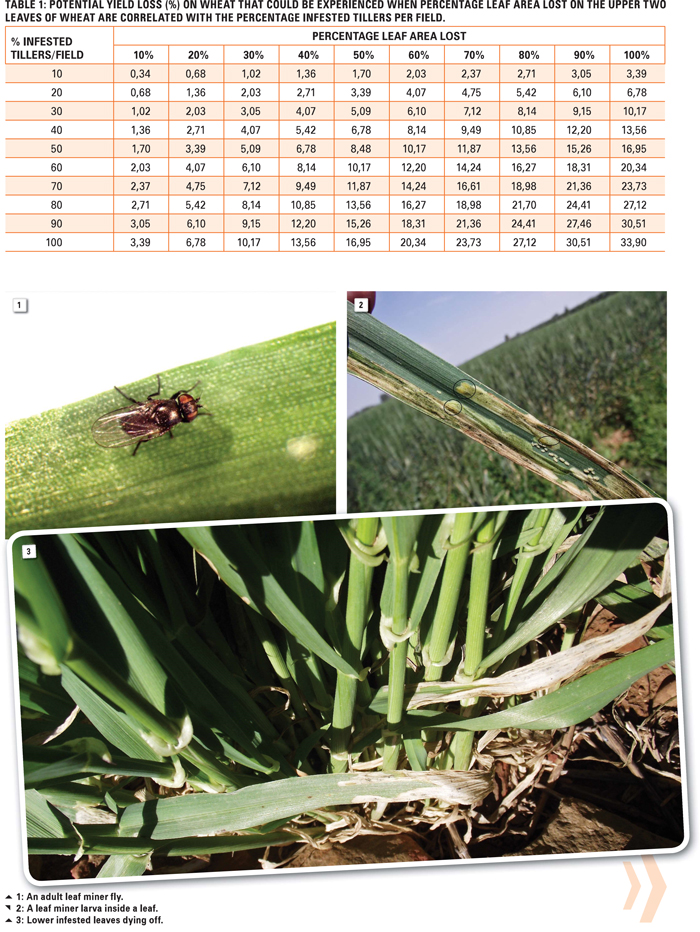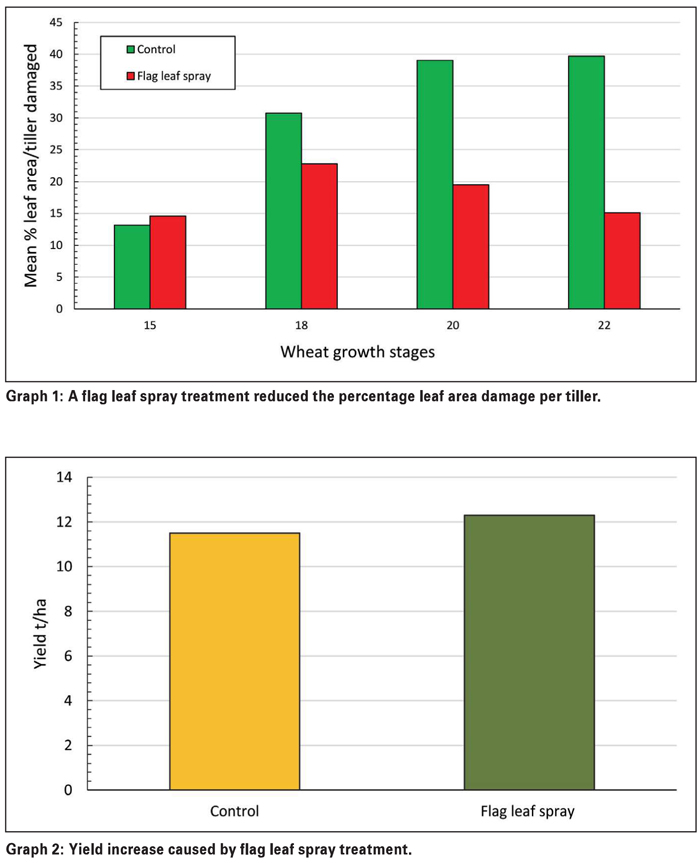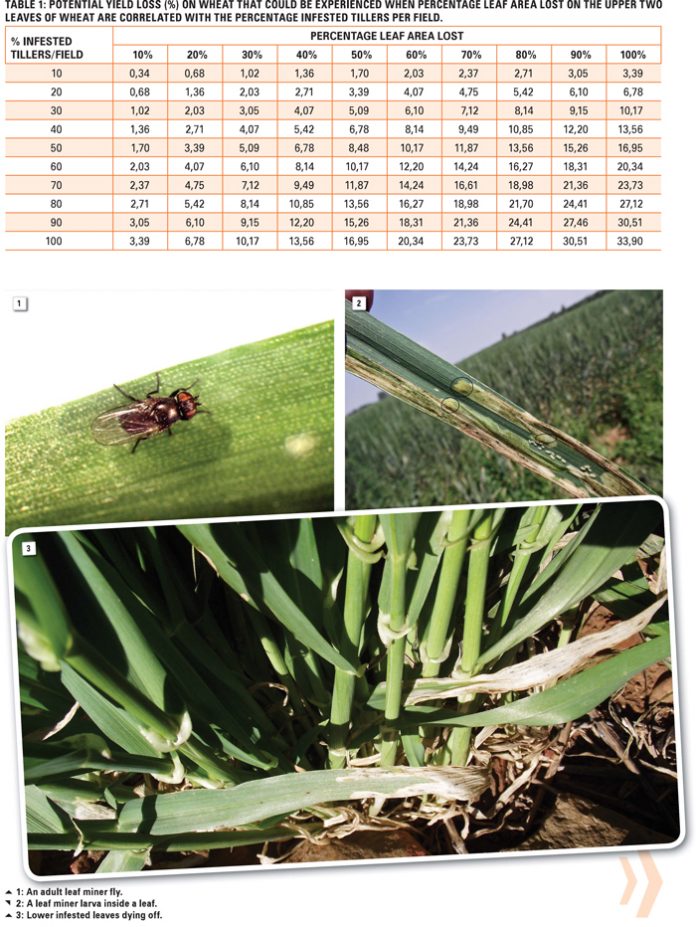May 2018
DR GODDY PRINSLOO, ARC-Small Grain, Bethlehem
What seems to be a few yellow larvae inside a wheat leaf in the year 2000, was the start of a new pest on wheat and barley. However, researchers are not certain if it is a pest…
Yellow leaf miner larvae were found in wheat leaves during 2000 in the Douglas and Prieska areas. The insect, identified as Agromyza ocularis (Photo 1), is an indigenous grass leaf miner fly that was originally described from natural vegetation in the Ceres, Giant’s Castle and Maseru areas.
Today, this fly is known on wheat and barley in almost all irrigated wheat production areas in South Africa. Since 2016, leaf miners have been present on dryland wheat in the Western Cape, which present a different situation to what we have encountered thus far. Infestation in this area started in the Heidelberg area, but spread through the whole production area, including the Swartland.
The female fly lays eggs inside host plant leaves and the larva mines inside the leaf, causing dead leaf tissue (Photo 2). Leaf mines develop firstly in the older leaves of the plant, since eggs tend to be pushed out of actively growing leaf tissue, giving them no chance to survive.
Visible leaf damage on irrigated plants can sometimes be serious, but yield loss, however, seems to be small, which renders it difficult to establish control measures.
Strong survival
This leaf miner has several characteristics built into its life cycle which could favour its survival under difficult circumstances. One is a diapause (resting stage), which could last for up to ten months. This occurs during the pupal stage, which is mostly present in the first 5 cm of top soil.
About 50% of the pupae will hatch into flies within about 23 days at a temperature of 25°C (Adendorff, 2010). The rest of the pupae will stay in the soil and will hatch occasionally over the next nine months.
Flies are therefore able to survive if small numbers of volunteer wheat, alternate hosts and natural grass become available. This could cause several successive populations in a wheat field, complicating control.

Infestation pattern in Western Cape
In the Western Cape, infestation is found early on new emerging wheat during May and specifically when it is dry. Drought causes reduced growth of the then very small plants. Fly eggs, laid in these small leaves, will hatch and larvae are able to grow and survive.
In the early growth stages, the yield characteristics (like numbers of tillers and kernels) become fixed and damage could influence yield potential. However, under dry conditions, plant development also slows down and damage to leaves may not have such a big influence.
A larval cycle is completed at 25°C (constant) within four to five days. However, with fluctuating temperatures in the field, duration could be extended up to ten days. Mature larvae leave the plant and pupate in the soil. The size of larvae should therefore be accounted for when considering chemical control.
A high percentage of mature larvae may mean that they will pupate in probably the next 48 hours. At this stage, maximum damage has already been suffered by the plant and a chemical application will not remedy the situation. On the other hand, if spraying is delayed until after the larvae leave the plant to pupate, the treatment of ‘empty’ leaves will be fruitless.
When rainfall occurs after initial infestation of small plants in the Western Cape, plant growth is rapid and newly laid eggs cannot survive in these plants. The first infested leaves die off on the soil surface (Photo 3).
No distinct damage to the plants is then visible. Several new infestation attempts may occur during the next few weeks with little effect. After heading, leaf growth slows down and new infestation is possible. Since the yield potential is fixed by then, grain number and mass could be affected by a heavy infestation.
 Experience under irrigation
Experience under irrigation
Field trials under irrigation demonstrated that spraying could reduce the level of leaf surface damage significantly per tiller (Graph 1). However, this reduction was not reflected by a significant yield increase on the sprayed treatment (Graph 2).
As stated earlier, the level of damage during the reproductive stages, is restricted only to the grain size and number of kernels.
So what should the producer do?
- Early infestation in the Western Cape tends to be severe, but as soon as enough rainfall occurs, plants seem to grow out of the problem.
- The leaf miner is therefore recognised as a pest, but not severe.
- When heavy infestations occur and you consider chemical control, apply the chemical while larvae are still in the leaves.
- Since weather conditions fluctuate, and notably so during the past few years, the situation should be monitored, with special attention to new infestations later in the season.
- During greenhouse trials, where both flag leaf and the second leaf were removed at flowering stage, yield reduction of 33% was measured. Thus, if both leaves are lost to leaf miner, significant yield loss could occur. However, to experience this level of damage, each tiller in the field should lose both upper leaves, a drastic situation not recorded yet. The potential damage was extrapolated from the greenhouse data as shown in Table 1. The table illustrates an indication when it could probably be worth spraying.
For further information on the problem, contact Dr Goddy Prinsloo at prinsloogj@arc.agric.za or 058 307 3435.
References 
Adendorff, J. 2010. The bio-ecology of the grass leaf miner, Agromyza ocularis (Diptera: Agromyzidae), on wheat and barley in the Northern Cape Province, South Africa. MSc. Thesis: University of the Free State.

Publication: May 2018
Section: On farm level


















